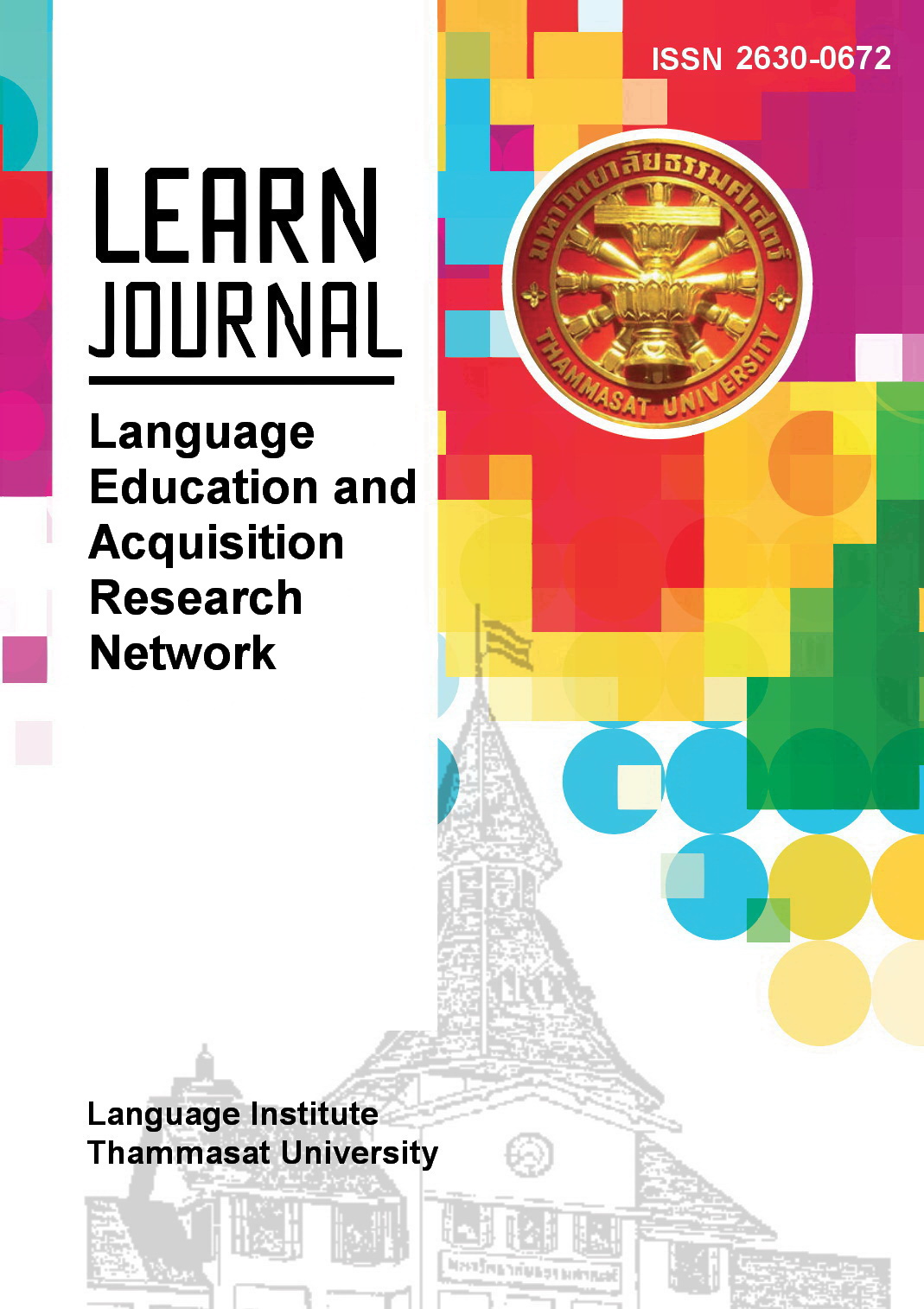A Corpus-Based Investigation of English Synonyms: Disadvantage, Downside, and Drawback
Main Article Content
Abstract
The study compares three synonymous nouns, disadvantage, downside, and drawback, in terms of their frequency, distribution patterns, and collocations, using data from the Corpus of Contemporary American English (COCA). The findings show that the frequency of disadvantage is the highest, followed by that of downside and drawback, respectively. Regarding their distribution across eight registers in COCA, disadvantage prevails in academic texts, whereas downside and drawback seem to be less formal as they are most often found in magazines. An analysis of semantic preferences of the verb collocates of the three synonyms revealed two common themes: CONSIDER and DEAL WITH. As for their adjective collocates, the three synonyms frequently co-occur with adjectives under the theme EXTENT. Disadvantage is more often preceded by adjectives subscribed to the theme ASPECT than drawback is, and while downside regularly combines with some adjectives representing counter-expectations, drawback tends to be accompanied by more adjective collocates organized into the theme PROMINENCE than the other two synonyms. It is advisable that English language teachers utilize these valuable insights to develop lessons and materials.
Article Details
References
Biber, D., Conrad, S., & Reppen, R. (1998). Corpus linguistics:
Investigating language structure and use. Cambridge University
Press.
Cambridge University Press. (n.d.). In Cambridge.org dictionary. Retrieved
March 10, 2022, from https://dictionary.cambridge.org/dictionary/english/
Cheng, W. (2012). Exploring corpus linguistics: Language in action.
Routledge.
Church, K.W., Gale, W., Hanks, P., Hindle, R., & Moon, R. (1994). Lexical
substitutability. In B. T. S. Atkins & A. Zampolli (Eds.), Computational approaches to the lexicon (pp. 153–177). Oxford University Press.
Cruse, D. A. (1986). Lexical semantics. Cambridge University Press.
Davies, M. (2010). The Corpus of Contemporary American English as the
first reliable monitor corpus of English. Literary and Linguistic
Computing: Journal of the Association for Literary and Linguistic Computing, 25(4), 447–464. https://doi.org/10.1093/llc/fqq018
Dewaele, J. (2008). Appropriateness in foreign language acquisition and
use: Some theoretical, methodological and ethical considerations. International Review of Applied Linguistics in Language Teaching, 46(3), 245–265.
DiMarco, C., Hirst, G., & Stede, M. (1993). The semantic and stylistic
differentiation of synonyms and near-synonyms. AAAL Spring Symposium on Building Lexicons for Machine Translation, 1, 114–121.
Edmonds, P., & Hirst, G. (2002). Near-Synonymy and lexical choice.
Computational Linguistics, 28(2), 105–144. https://doi.org/10.1162/089120102760173625
Firth, J. R. (1957), A synopsis of linguistic theory. In Studies in Linguistic
Analysis (pp. 1930–1955). Blackwell.
Gablasova, D., Brezina, V., & McEnery, T. (2017). Collocations in corpus‐
based language learning research: Identifying, comparing, and interpreting the evidence. Language Learning, 67(S1), 155-179.
Goodman, N. (1952). On likeness of meaning. In L. Linsky (Ed.),
Semantics and the philosophy of language (pp. 67–74). University of Illinois Press.
HarperCollins Publishers. (n.d.). In Ahdictionary.com. Retrieved March 10,
, from https://ahdictionary.com
Hornby, D. (2014). Linguistics: A complete introduction. Hachette.
Hunston, S. (2002). Corpora in applied linguistics. Cambridge University
Press.
Jarunwaraphan, B., & Mallikamas, P. (2020). A corpus-based study of
English synonyms: ‘Chance’ and ‘opportunity’. REFLections, 27(2),
–245.
Jaszczolt, K. (2002). Semantics and pragmatics: Meaning in language and
discourse. Longman.
Jirananthiporn, S. (2018). Is this problem giving you trouble? A corpus-
based examination of the differences between the nouns ‘problem’ and ‘trouble’. Thoughts, 2, 1-25.
Lee, C. & Liu, J. (2009). Effects of collocation information on learning
lexical semantics for near synonym distinction. Computational Linguistics and Chinese Language Processing, 14(2), 205-220.
Lindquist, H. (2009). Corpus linguistics and the description of English.
Edinburgh University Press.
Liu, D. (2010). Is It a ‘chief’, ‘main’, ‘major’, ‘primary’, or ‘principal’
concern? A corpus-based behavioral profile study of near-synonyms. International Journal of Corpus Linguistics, 15(1), 56–87. https://doi.org/10.1075/ijcl.15.1.03liu
Mackay, S. (1980). Teaching the syntactic, semantic, and pragmatic
dimensions of verbs. TESOL Quarterly, 14, 17-26.
Martin, M. (1984). Advanced vocabulary teaching: The problem of
synonyms. The Modern Language Journal, 68 (2), 130-137.
McEnery, T. & Hardie, A. (2012). Corpus linguistics: Method, theory and
practice. Cambridge University Press.
Merriam-Webster. (n.d.). In Merriam-Webster.com dictionary. Retrieved
March 10, 2022, from https://www.merriam-webster.com
Oxford University Press (n.d.). In Oxfordlearners.com dictionaries.
Retrieved March 10, 2022, from https://www.oxfordlearnersdictionaries.com/definition/american_english
Palmer, H. E. (1933). Second interim report on English collocations.
Kaitakusha.
Partington, A. (2004). Utterly content in each other’s company: Semantic
prosody and semantic preference. International Journal of Corpus Linguistics, 9(1), 131-156.
Phoocharoensil, S. (2020). A genre and collocational analysis of consequence, result, and outcome. 3L: The Southeast Asian Journal of English Language Studies, 26(3), 1–16.
https://dx.doi.org/10.17576/3L-2020-2603-01
Phoocharoensil, S. (2021). Semantic prosody and collocation: A corpus
study of the near-synonyms ‘persist’ and ‘persevere’. Eurasian Journal of Applied Linguistics, 7(1), 240–258.
https://doi.org/10.32601/ejal.911269
Pojanapunya, P., & Todd, R. W. (2018). Log-likelihood and odds ratio:
Keyness statistics for different purposes of keyword analysis. Corpus Linguistics and Linguistic Theory, 14(1), 133-167. https://doi.org/10.1515/cllt-2015-0030
Quine, W. V. O. 1951. Two dogmas of empiricism. Philosophical Review,
, 20–43.
Schmitt, N. (2010). Research vocabulary: A Vocabulary research manual.
Palgrave Macmillan.
Sinclair, J. (2004). Trust the text. Routledge.
Sinclair, J., Susan J., & Robert D. (2004) English collocation studies: The
OSTI report (Krishnamurthy, R. (Ed.). Continuum.
Stubbs, M. (2001). Words and phrases: Corpus studies of lexical
semantics. Blackwell.
Stubbs, M. (2002). Two quantitative methods of studying phraseology in
English. International Journal of Corpus Linguistics, 7 (2), 215–244.
Szudarski, P. (2018). Corpus linguistics for vocabulary: A guide for
research. Routledge.
Webb, S. & Nation, P. (2017). How vocabulary is learned. Oxford
University Press.
Xiao, R. Z. & McEnery, A. M. (2006). Collocation, semantic prosody and
near synonymy: A crosslinguistic perspective. Applied Linguistics, 27(1), 103-129. https://doi.org/10.1093/applin/ami045


